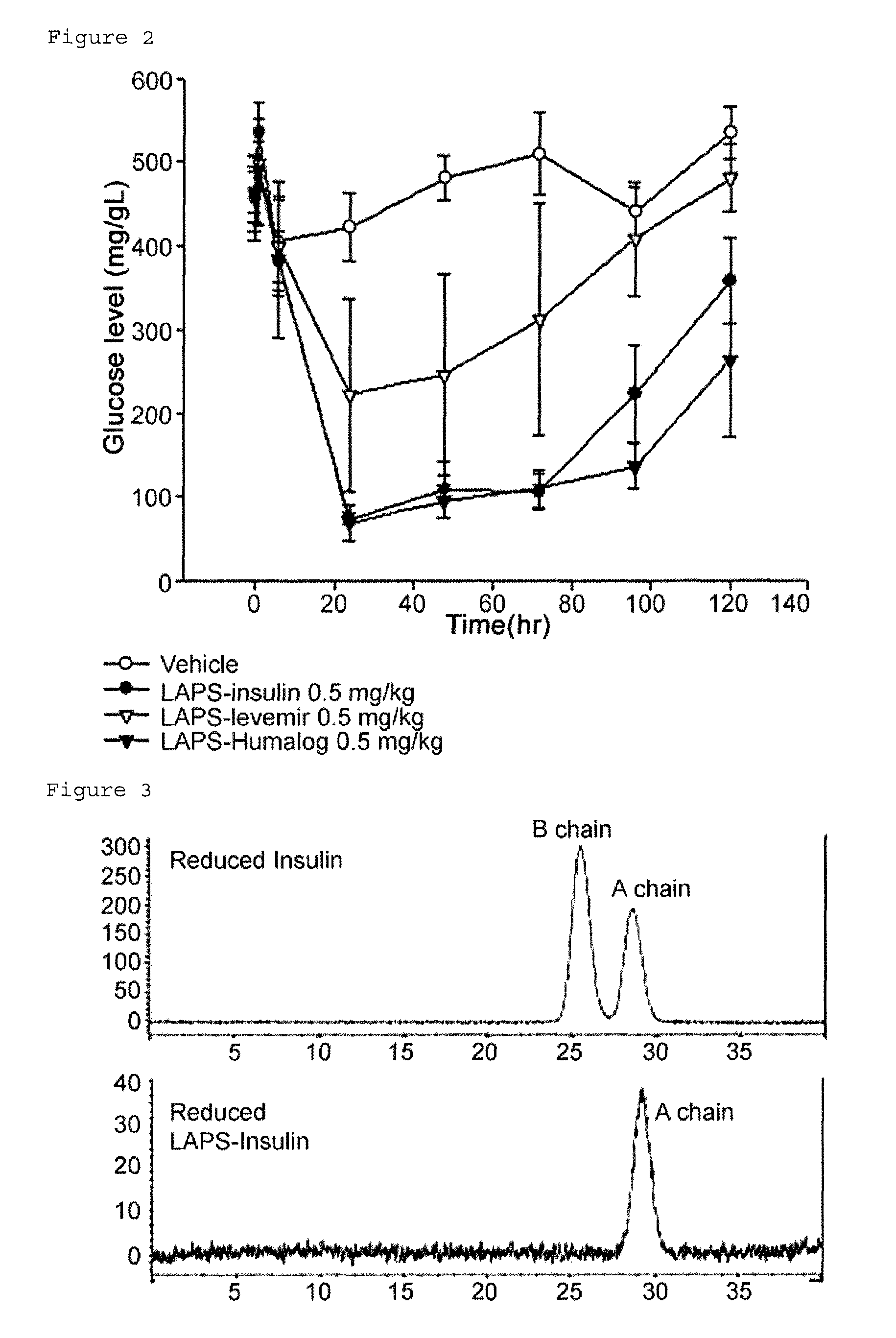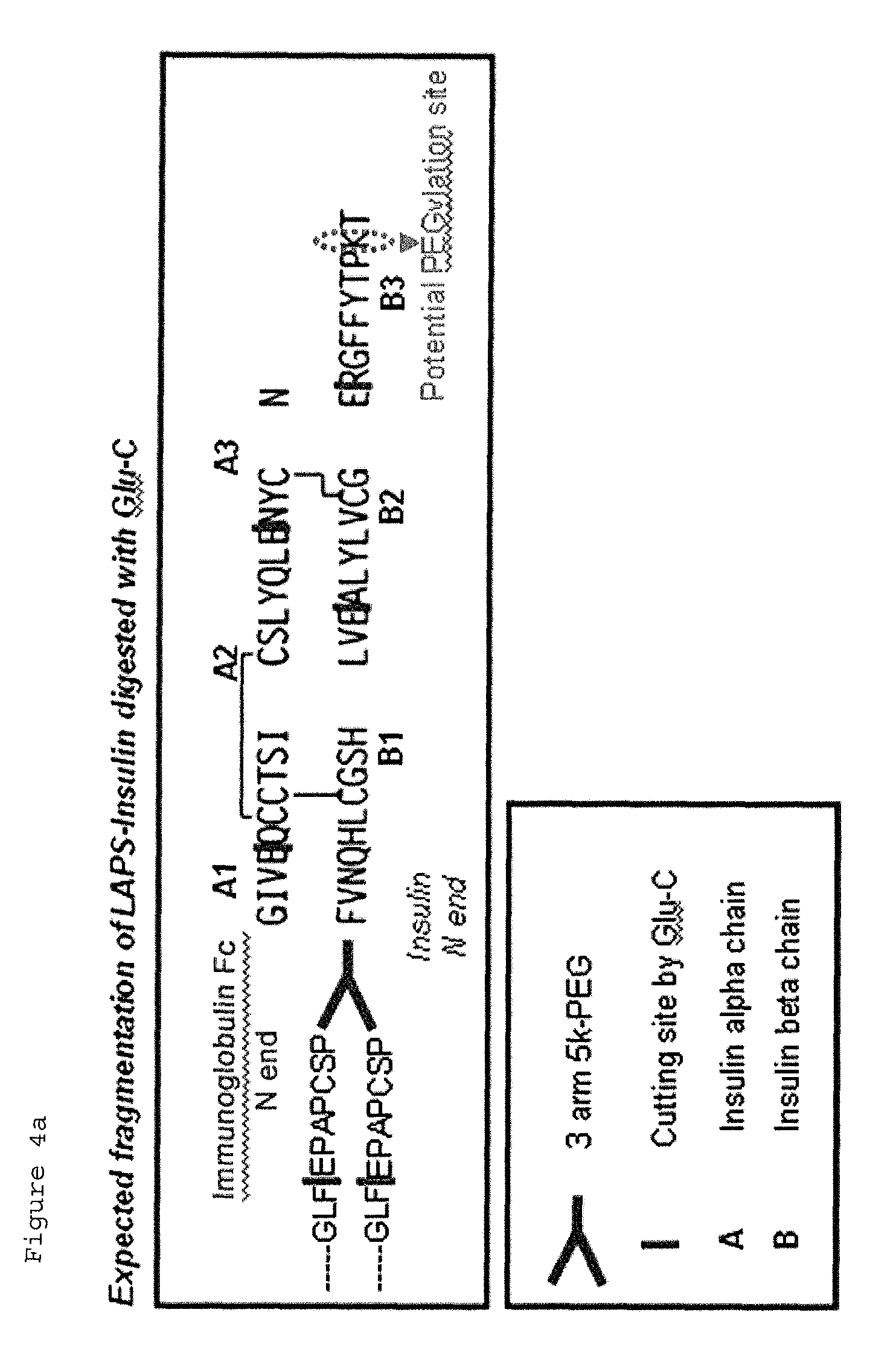Insulin conjugate using an immunoglobulin fragment
a technology of immunoglobulin and conjugate, which is applied in the field of conjugate, can solve the problems of diabetes, pain or discomfort of patients, blood glucose level not being regulated, etc., and achieve the effects of improving drug compliance of patients, high level, and increasing the serum half-li
- Summary
- Abstract
- Description
- Claims
- Application Information
AI Technical Summary
Benefits of technology
Problems solved by technology
Method used
Image
Examples
example 1
Purification of Pegylated Immunoglobulin Fc Region
[0079]For pegylation of the immunoglobulin Fc at its N-terminus, 5K PropionALD (3) PEG (PEG having three propylaldehyde groups, NOF, Japan) was used to perform pegylation by reacting the immunoglobulin Fc and PEG at 4° C. for 4.5 hrs and at a molar ratio of 1:2, with an immunoglobulin Fc concentration of 10 mg / ml. At this time, the reaction was performed in a 100 mM potassium phosphate buffer solution at pH 6.0, and 20 mM SCB (NaCNBH3) as a reducing agent was added thereto. A mono-PEGylated immunoglobulin Fc was purified from the reaction solution using a Source 15Q (GE Healthcare) column.
example 2
Preparation of Insulin-PEG-Immunoglobulin Fc Conjugate
[0080]To prepare an insulin-PEG-immunoglobulin Fc conjugate having 90% or more pegylation at phenylalanine (B1F) of the beta chain of insulin, the mono-PEGylated immunoglobulin Fc obtained in Example 1 and insulin were reacted at a molar ratio of 4:1 and at 4° C. for 20 hrs, with a total protein concentration of 20 mg / ml. At this time, the reaction was performed in a 100 mM potassium phosphate buffer solution at pH 6.0, and 20 mM SCB as a reducing agent was added thereto. After the reaction was terminated, the reaction solution was subjected to primary purification using a Source 15Q column. Thereafter, secondary purification was performed using a Source 15ISO column to obtain an insulin-PEG-immunoglobulin Fc conjugate. A size exclusion column was used to analyze 90% or more pegylation of B1F of the obtained insulin-PEG-immunoglobulin Fc conjugate, and the results are shown in FIG. 3.
example 3
Preparation of Insulin Lispro (Humalog)-PEG-Immunoglobulin Fc Conjugate
[0081]The mono-PEGylated immunoglobulin Fc obtained in Example 1 and insulin lispro were reacted at a molar ratio of 4:1 and at 4° C. for 20 hrs, with a total protein concentration of 20 mg / ml. At this time, the reaction was performed in a 100 mM potassium phosphate buffer solution at pH 6.0, and 20 mM SCB as a reducing agent was added thereto. After the reaction was terminated, purification was performed in the same manner as in Example 2.
PUM
| Property | Measurement | Unit |
|---|---|---|
| molecular weight | aaaaa | aaaaa |
| molecular weight | aaaaa | aaaaa |
| molecular weight | aaaaa | aaaaa |
Abstract
Description
Claims
Application Information
 Login to View More
Login to View More - R&D
- Intellectual Property
- Life Sciences
- Materials
- Tech Scout
- Unparalleled Data Quality
- Higher Quality Content
- 60% Fewer Hallucinations
Browse by: Latest US Patents, China's latest patents, Technical Efficacy Thesaurus, Application Domain, Technology Topic, Popular Technical Reports.
© 2025 PatSnap. All rights reserved.Legal|Privacy policy|Modern Slavery Act Transparency Statement|Sitemap|About US| Contact US: help@patsnap.com



